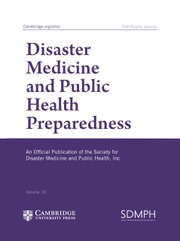Dengue, a mosquito-borne viral disease, is endemic to Peru, with the annual number of cases ranging between 4698 and 68 290 from 2017-2022. But only in the first half of 2023, 139 366 confirmed dengue cases, including 381 mortalities, were reported, making this the largest dengue outbreak on record in Peru.Reference Munayco, Rosales and Lizarbe 1 It is reported that hospitals in the worst affected regions did not have enough beds for the surge in patient admissions. The authorities struggled to contain the outbreak and Peru’s minister for health stepped down. causing further turmoil in the country.Reference Taylor 2
Discussion
The Ministry of Health of Peru, in collaboration with regional health offices and international partners, implemented a broad, integrated surveillance and response strategy, including increased targeted larvicidal treatments of standing water and insecticide spraying in affected neighborhoodsReference Munayco, Rosales and Lizarbe 1 to control the spread of disease, but the conditions only worsened in 2024 due to drastic climate change. Since December 1 2023, the impact of heavy rains has caused flooding, landslides, and hailstorms throughout the country. The accumulation of water from the rains creates a breeding ground for dengue. According to UNICEF, the rise of dengue among the population led the Ministry of Health to declare a Health Emergency on February 28, 2024, as the number of cases more than doubled this year than in 2023. Children and adolescents infected with dengue were more than 10 000, representing 29.6% of the infected population and 13.6% of the deaths. 3 This rapidly worsening crisis is out of control of the already overwhelmed local authorities, as claimed by the government officials, especially in the areas with limited access to public services owing to floods and subsequent landsliding. 3
Conclusions
Due to the catastrophic effects of El Niño Southern Oscillation (ENSO), more than half the population of Peru is at risk of dengue infection.Reference Dostal, Meisner and Munayco 4 World organizations, health care authorities, and government officials should take emergency measures to control the spread of dengue and check the increasing mortality rates in Peru. Furthermore, the areas with limited access to health care should be targeted and health care operations should be facilitated there. Despite the alarming figures, this is likely an underestimate of the real prevalence and burden of the disease, given the underreporting, misclassification, and limitations of the health systems in some countries.Reference Suaya, Shepard and Siqueira 5
Author contribution
Conceptualization: Haider Ashfaq; Writing – original draft: Haider Ashfaq, Hamza Ashraf, Mahad Butt; Writing – review & editing: Aiman Ashfaq, Hamza Ashraf
Funding statement
None to declare.
Competing interest
None to declare.


